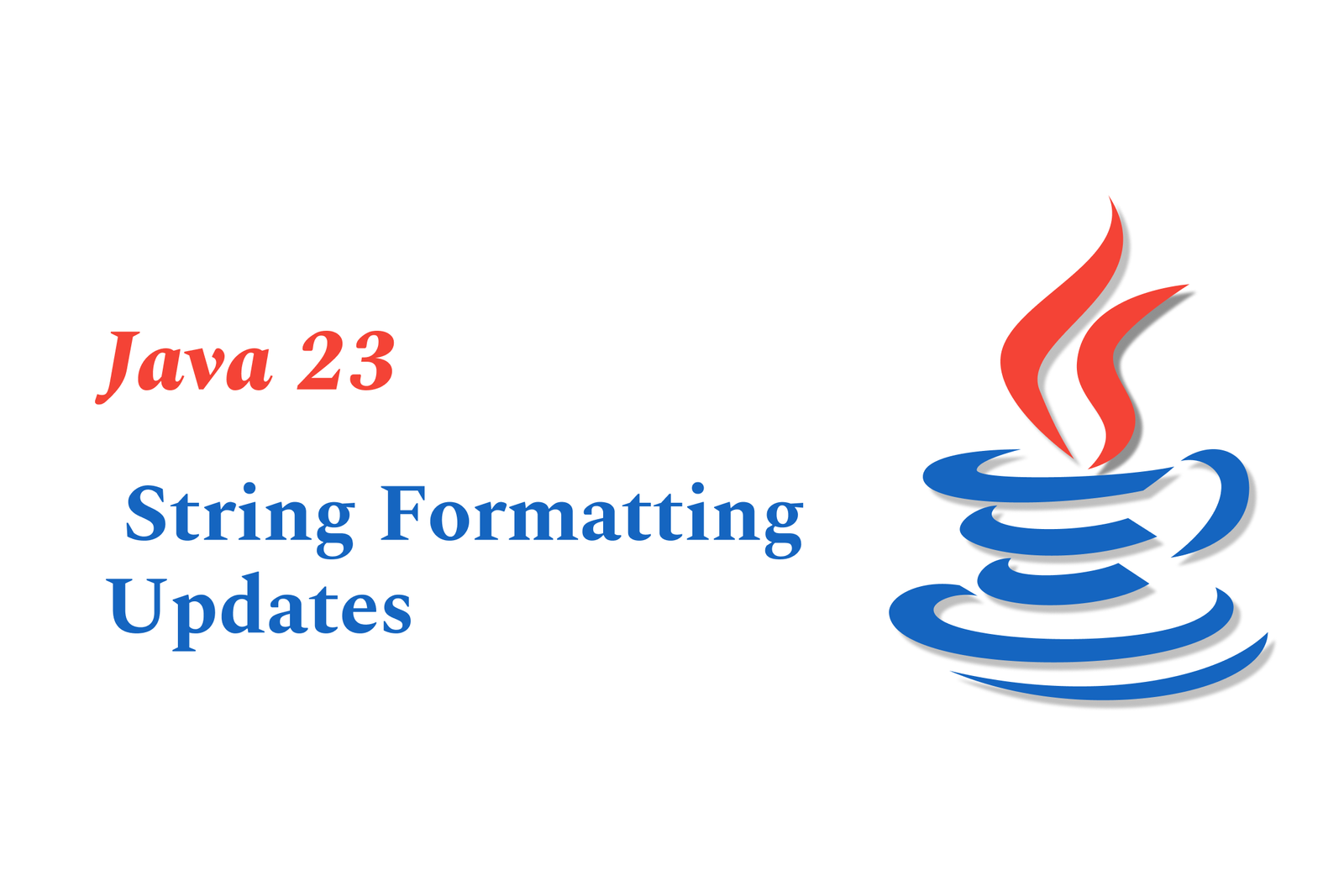Java 23 String Formatting Updates
Java 23 enhances string formatting with improved performance and continued support for `String.format()` placeholders, allowing precise control over output. While it doesn’t introduce string templates yet, it sets the foundation for more efficient and expressive string handling in future releases.
Java 23 String Formatting Updates
1 ) Overview of Java String Formatting
Java offers multiple methods for formatting strings, primarily using concatenation with the `+` operator and the more flexible `String.format()` method. While concatenation is straightforward for quick output, `String.format()` provides powerful formatting features with placeholders.
2 ) Concatenation vs. Formatted Strings
Concatenation: Uses the `+` operator to join string literals and variables directly. It automatically converts primitive types to strings.
Formatted Strings: Utilizes `String.format()` with placeholders such as `%s`, `%d`, and `%f` to insert strings, integers, and floating point numbers, respectively.
3 ) Using `String.format()`
The method is static and called directly from the `String` class.
The first argument is a format string containing placeholders.
Subsequent arguments correspond to values replacing placeholders in order.
Example:
java
int sum = 123;
double avg = 1 )23;
String name = “Student”;
String output = “%s: Your score is %d with an average of %f.”;
System.out.println(String.format(output, name, sum, avg));
Output:
`Student: Your score is 123 with an average of 1 )230000.`
4 ) Advanced Formatting Options
Width and precision can be specified in placeholders (e.g., `%5d`, `%8.4f`):
`%5d` pads the integer to a width of 5 characters, adding spaces if necessary.
`%8.4f` formats a floating point number to 8 characters wide with 4 decimal places.
Example:
java
String output = “%s: Your score is %5d with an average of %8.4f.”;
System.out.println(String.format(output, name, sum, avg));
Output:
`Student: Your score is 123 with an average of 1 )2300.`
5 ) Java 23 String Formatting Improvements
While Java 23 does not introduce string templates yet (confirmed no preview feature for JDK 23 ), it enhances pattern matching and other language features indirectly benefiting string handling.
Performance improvements continue, building on Java 17’s 3x faster `String.format()` execution.
6 ) Additional Related Features
Pattern matching for primitive types (JEP 455 ) allows smoother integration of primitive values in switch expressions which can impact how strings are constructed after matching.
Simplified main method declarations (JEP 463, 476, 477 ) reduce boilerplate and support concise code that frequently produces formatted outputs.
7 ) Summary
Java's string formatting remains highly versatile, using `String.format()` for flexible, readable, and well aligned output strings. Java 23 prioritizes enhanced language features and performance, setting the stage for future improvements such as string templates, which are postponed beyond JDK 23.
https://justacademy.in/news-detail/android-security-best-practices-updates
https://justacademy.in/news-detail/react-native?s-secret-sauce-for-lightning-fast-startups
https://justacademy.in/news-detail/government-apps-built-using-flutter
https://justacademy.in/news-detail/flutter-state-management-in-2025:-what’s-trending?
https://justacademy.in/news-detail/google-i/o-2025-highlights:-flutter-takes-the-lead
Related Posts
In 2025, top Angular libraries offer modern, feature-rich components and tools for building dynamic web apps. From powerful data grids to low-code platforms like UI Bakery, these libraries enhance development speed, UI design, and scalability, making them essential for Angular developers.
Migrating from AngularJS to Angular 17 involves gradually upgrading your app by running both frameworks together using tools like ngUpgrade, rewriting components in TypeScript, and adopting Angular’s modern architecture to enhance performance, maintainability, and long-term support.
Angular state management tools help organize and handle app data efficiently, improving scalability and maintainability. Popular options include NgRx for robust, RxJS-based patterns, and newer Signal Store solutions that offer simpler, reactive approaches integrated tightly with Angular’s latest features.
RxJS in Angular empowers developers to manage asynchronous data streams with powerful operators like `forkJoin`, `combineLatest`, and `zip`. Mastering these key operators in 2025 is essential for building efficient, reactive applications that handle complex event sequences seamlessly.
Angular performance optimization in 2025 focuses on improving app speed and responsiveness by using techniques like OnPush change detection, lazy loading, efficient data caching, and AOT compilation. These practices reduce load times, enhance user experience, and ensure scalable, fast Angular applications.
In 2025, Angular remains preferred for large-scale, enterprise apps with its robust, all-in-one framework, while Vue attracts developers seeking simplicity and fast development for smaller projects. Both frameworks excel, with choice driven by project needs and team expertise.
Angular Signals are a new reactive primitive in Angular 16 that enable fine-grained, efficient change detection by automatically tracking dependencies and updating only affected parts of the UI. They simplify state management and boost app performance, revolutionizing Angular's reactivity model.
Angular interview questions to prepare in 2025 focus on core concepts like components, directives, data binding, routing, and dependency injection, along with TypeScript mastery and latest Angular features to ensure strong practical knowledge for building scalable, efficient web applications.
AngularJS reached its official end of support in January 2022, meaning no further updates or security patches. To ensure app security and performance, developers should consider migrating to modern Angular versions or seek third-party long-term support options if immediate migration isn’t possible.
The Angular Roadmap 2025 highlights upcoming features focused on improving developer experience and performance, including zoneless Angular, Signals integration, enhanced Forms, async data handling, improved HMR, and expanded Angular Material/CDK enhancements, driving modern, efficient web app development.










